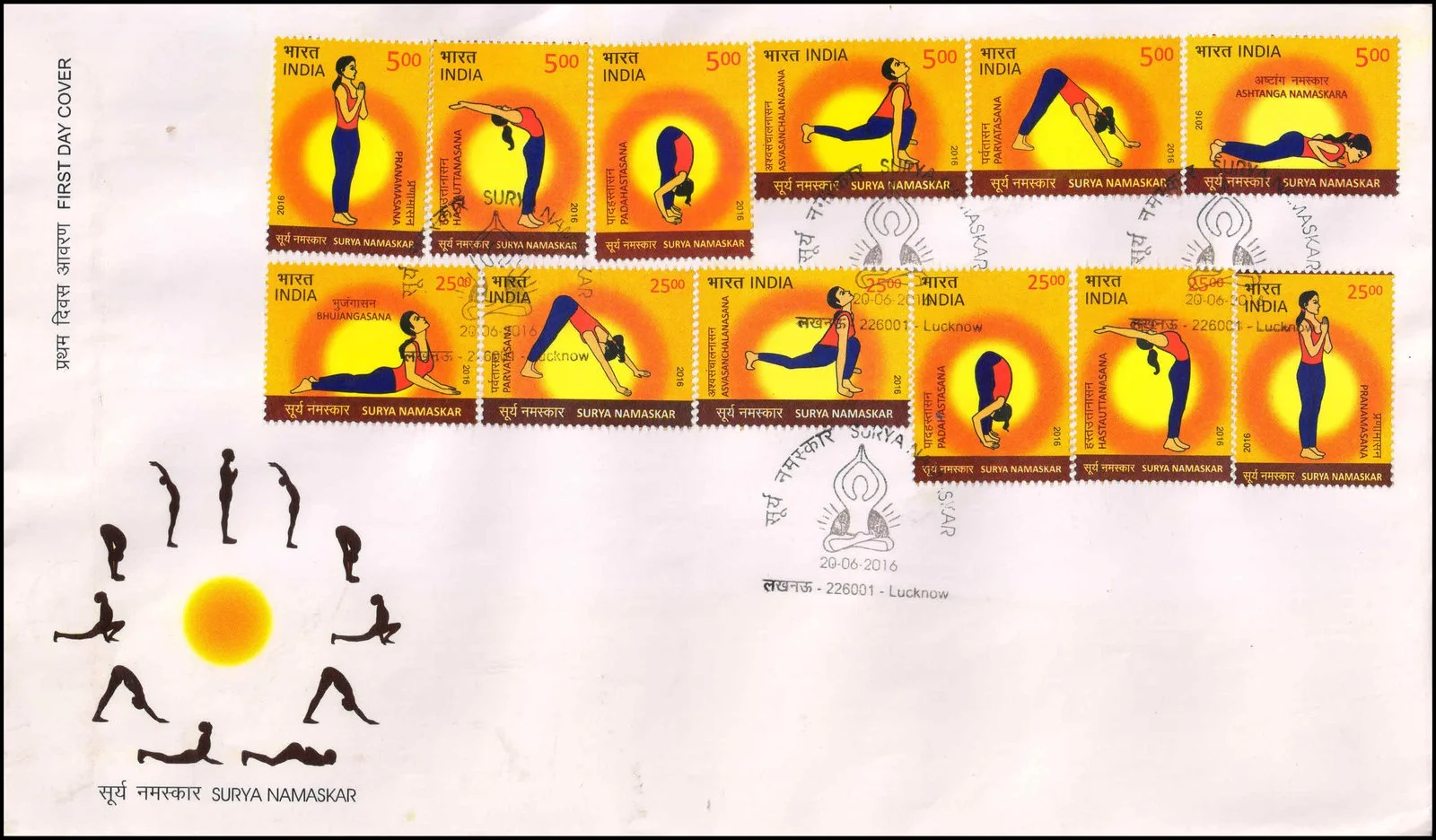Padahastasana

Technical Data
| Stamp Set | Surya Namaskar |
|---|---|
| Date of Issue | June 20, 2016 |
| Denomination | Rs. 5 |
| Quantity | 300,000 |
| Perforation | 13¾ x 13¼ |
| Printer | Security Printing Press, Hyderabad |
| Printing Process | Wet Offset |
| Watermark | No Watermark |
| Colors | Multicolor |
| Credit (Designed By) | Ms. Nenu Gupta |
| Catalog Codes |
Michel IN 2968A Yvert et Tellier IN 2682 Stanley Gibbons IN 3139 |
| Themes | Women |
Introduction
Padahastasana, known as the Hand-to-Foot Pose, is the third and tenth posture of the Surya Namaskar sequence. The Sanskrit words ‘Pada’ mean foot and ‘Hasta’ means hand. This asana embodies the principle of bowing forward in humility while enhancing physical flexibility and inner calm. By bringing the head close to the knees, it promotes surrender, grounding, and introspection.
Origin and Significance
Padahastasana has its roots in ancient yogic traditions that emphasize physical purification and mental discipline. Forward-bending postures like this one are symbolic of releasing ego and tension, allowing the practitioner to look inward with a calm mind. The pose relaxes the nervous system and energizes the body by improving blood circulation to the brain, encouraging clarity, balance, and emotional stability.
How to Practice Padahastasana
- From Hastauttanasana, exhale slowly and bend forward from the hips.
- Lower the head and arms towards the feet, keeping the spine long and knees straight.
- Place the hands beside the feet or touch the toes or floor with the fingers or palms.
- Aim to bring the forehead gently toward the knees without straining.
- Maintain the posture with awareness on the pelvic region and slow, deep breathing.
Over time, flexibility improves naturally—forcing or jerking the body should be avoided.
Benefits of Padahastasana
Padahastasana offers significant benefits that enhance flexibility, improve circulation, and calm the mind.
Physical Benefits
- Stretches hamstrings, calves, hips, and the entire back
- Strengthens thighs and stimulates nerves of the spine
- Improves posture and spinal flexibility
- Massages abdominal organs and supports digestive health
Mental and Emotional Benefits
- Relieves stress, anxiety, and mental fatigue
- Promotes a sense of grounding, humility, and emotional balance
- Enhances concentration and inner focus
Circulatory and Nervous System Benefits
- Increases blood flow to the brain, enhancing mental alertness and memory
- Helps reduce fatigue and rejuvenates the nervous system
Role in Surya Namaskar
As the third and tenth posture, Padahastasana provides an important transition from the upward stretch of Hastauttanasana to the dynamic flow of forward and backward movements. It helps prepare the body for deeper stretches ahead and offers a counterbalance by lengthening the back and relaxing the muscles after the backward arch. This posture harmonizes the breath and supports a meditative flow throughout the Surya Namaskar sequence.
Conclusion
Padahastasana is a transformative posture that combines physical stretching with mental relaxation. It enhances flexibility, stimulates vital organs, improves blood circulation, and quietens the mind. By fostering humility and inward awareness, this asana supports emotional well-being while strengthening the body. Practiced regularly as part of Surya Namaskar, it contributes to a balanced, flexible, and refreshed state of being.
Commemorative Stamps on Surya Namaskar
To mark International Yoga Day on 21 June 2016, the Department of Posts released a set of 12 Commemorative Postage Stamps, each depicting one of the 12 positions of Surya Namaskar—highlighting Yoga’s cultural and spiritual significance.
First Day Cover

